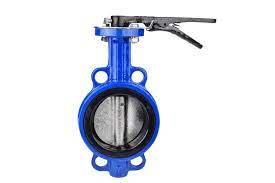Get In Touch
Get In Touch




A butterfly valve is a versatile flow control device used in pipelines to regulate the flow of fluids. Its unique design features a disc, resembling a butterfly, which rotates within the valve body to either block or allow the passage of liquids or gases. By adjusting the angle of the disc, operators can finely control the flow rate. Butterfly valves are valued for their lightweight construction, minimal pressure drop, and fast on/off operation. They find applications in various industries, including water treatment, HVAC, chemical processing, and power generation, where efficient, cost-effective fluid control is essential.
Valve Type: Butterfly Valve Size Range: Butterfly valves come in various sizes, with diameters typically ranging from 2 inches to over 80 inches, suitable for a wide range of applications.
Valve Design: Butterfly valves can be of various designs, including: - Wafer-Type: Designed to fit between flanges, these valves are compact and lightweight. - Lug-Type: These valves have threaded lugs for installation between flanges. - Flanged-End: These valves have flanges for direct bolting to the pipeline. - Double Offset: Features a slight offset of the stem and disc for enhanced sealing and reduced friction. Body Material: Butterfly valve bodies are commonly made from materials such as cast iron, ductile iron, carbon steel, stainless steel, and various alloys, chosen based on factors like fluid compatibility and application.
Seat Material: The valve seat material is typically made of elastomers like EPDM, Buna-N, PTFE, or metal, ensuring a reliable seal.
Disc Material: The disc material varies based on the application and can be made of materials like stainless steel, cast iron, or other alloys.
Actuation: Butterfly valves can be manually operated (lever or handwheel) or automated (electric, pneumatic, hydraulic, or gear-operated) for remote control.
Pressure Rating: Indicates the maximum allowable pressure the valve can withstand, typically expressed in pounds per square inch (PSI) or bars.
Temperature Rating: Specifies the temperature range within which the valve can operate safely, typically expressed in degrees Celsius (°C) or Fahrenheit (°F). Flow Characteristic: Butterfly valves generally have a linear flow characteristic, making them suitable for applications requiring modulating flow control.
Leakage Class: The valve's leakage class defines the allowable leakage rate when the valve is closed, typically classified as zero leakage, tight shut-off, or other specific classes.
End Connections: Butterfly valves can have various end connections, such as wafer, lug, flanged, or grooved ends, based on installation and piping requirements.
Certifications: Depending on the application, butterfly valves may need to comply with specific industry standards and certifications, such as API, ANSI, or ISO.
Accessories: Some butterfly valves may include accessories like limit switches, solenoid valves, and positioners for automated operation.
Corrosion Resistance: Butterfly valves may be equipped with coatings or linings to enhance their resistance to corrosion.
1. Water Treatment: Butterfly valves control the flow of water in treatment plants, regulating processes like filtration, chlorination, and distribution.
2. HVAC Systems: In heating, ventilation, and air conditioning systems, butterfly valves are used to regulate airflow and control the temperature in commercial and residential buildings.
3. Chemical Processing: Butterfly valves handle the control of corrosive chemicals, acids, and bases, ensuring the safety and efficiency of chemical manufacturing processes.
4. Power Generation: Butterfly valves manage cooling water, steam, and fuel supply in power plants, helping to control various aspects of power generation.
5. Oil and Gas Industry: They are used for pipeline flow control, tank farms, and offshore drilling operations, managing the flow of oil, gas, and petrochemical products.
6. Fire Protection Systems: Butterfly valves play a crucial role in fire protection systems, controlling water flow to fire sprinklers and hydrants.
7. Marine Industry: They are used in shipbuilding and maritime applications for seawater and wastewater management, as well as ballast and bilge systems.
8. Pharmaceuticals: Butterfly valves are employed in pharmaceutical manufacturing to control the flow of materials during production and packaging processes.
9. Food and Beverage Processing: In food and beverage industries, they manage the flow of liquids and gases, ensuring precise dosing and quality control.
10. Mining and Minerals: Butterfly valves regulate the flow of ores, slurries, and other materials in mining and mineral processing operations.
11. Wastewater Treatment: These valves are used in wastewater treatment facilities to control the flow of sewage, sludge, and chemicals, facilitating treatment processes.
12. Agriculture: In agriculture, butterfly valves are used for irrigation, controlling water flow to fields and crops.
13. Pulp and Paper Industry: They manage the flow of pulp, chemicals, and water in paper manufacturing processes.
14. Semiconductor Manufacturing: Butterfly valves are used to control ultra-pure gases and chemicals in semiconductor fabrication.
15. Automotive Industry: In vehicle manufacturing, they control paint and lubricant flow during the production process.
16. Material Handling: Butterfly valves can be used to control the flow of bulk materials, such as powders and granules, in material handling systems.
17. Chemical Transport: In tank trucks and railcars, butterfly valves manage the flow of chemicals during transportation. These applications demonstrate the wide utility of butterfly valves in industries where precise flow control, reliability, and ease of operation are essential.


